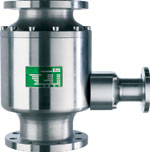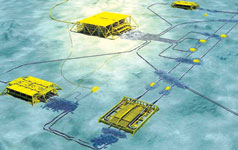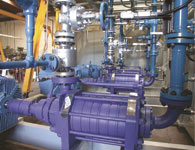

Wherever pumps are in operation, there is a need for special valves which protect those pumps against damage that may occur as a result of a partial evaporation of the pump content when it is operated under light load. The Schroeder automatic recirculation valve (SSV), presented in this article, can provide all the desired protection functions and fully meets the requirements regarding reliability and low maintenance as is shown in the examples that follow.
The devastating consequences of the earthquake and the ensuing tsunami in Japan in 2011 led to a different attitude towards nuclear power in Japan itself and many other countries in the Western Hemisphere. Germany has even gone so far as committing to phase out nuclear power. Its 19 nuclear power plants will be out of operation as early as 2022. Even if Germany‘s drastic action is not likely to be followed by many other states, the need for other sources of energy will increase with the increasing demand for energy and with global warming as a result of the still increasing level of carbon dioxide. Ever more sophisticated ways of exploitation of fossil fuels will play a role in this as will the increased production of renewable energies. No matter what source of energy, there are always pumps involved in its production. And where there are pumps in operation, there is a need for special valves which protect those pumps against damage that may occur as a result of a partial evaporation of the pump content when it is operated under little load. It is desirable that these valves are highly reliable, low maintenance and ensure low pressure loss and low cavitation levels. The valves should be self-actuated i.e. there should be no need for an actuator or auxiliary power supply.
The Schroeder automatic recirculation valve
There are only very few producers in the world who can design this type of valve. The Schroeder automatic recirculation valve (SSV) can provide all needed protection functions and fully meets the requirements regarding reliability and low maintenance: as a result of the rotary bypass trim design, modulating and low-wear minimum flow control is guaranteed. The SSV valves have a non-return function in the main pumping direction which prevents pump damage by back flow from the process line at shut-off and standby respectively. A multi-stage pressure reduction in the secondary outlet ensures low cavitation levels. The valves are further praised for low pressure loss in main direction and high reliability with long service life. Each SSV is specially designed for the required pump and system data. For more than 50 years Schroeder automatic recirculation valves have been successfully in operation in nuclear power plants, in coal-fired power plants and in the offshore industry all over the world. In recent years the demand for those special valves has also increased also in solar power plants, in wind farms and hydroelectric power stations, as well as in biomass power plants.

High-tech gas production in Norway
A perfect example for the ever more sophisticated exploitation of fossil fuels is Ormen Lange, Europe‘s third largest natural gas field. What makes the ‘long worm’ so challenging to exploit is its situation: it lies about 3000 metres below sea level, 120 kilometres northwest of Kristiansund in the Norwegian continental shelf, where seabed depths vary between 800 and 1100 metres. Pipelines and installations had to be placed on the extremely steep and uneven area of the sea bed. In addition, the installations must withstand the exceptional currents that are characteristic of this part of the Norwegian Sea, as well as sub-zero temperatures on the sea bed, and extreme wind and wave conditions. All this puts great demands on the technology used in the project. Due to the conditions the development of Ormen Lange is different from all other offshore projects: there is not a single platform on the surface of the sea above the gas field. Instead, 12 subsea wellheads at three seabed templates were installed on the ocean floor and connected directly by two pipelines to an onshore process terminal at Nyhamna on the Norwegian coast. There the gas is purified, dried and compressed before it is exported through the world‘s longest subsea gas pipeline approximately 1200 kilometres to the reception centre in Easington on the east coast of the UK. Ever since gas production started in 2007 the field has been recovered by pressure depletion only, but as production continues, the natural pressure in the reservoir will decline and a need for compression will arise. The licence partners are therefore going to install a subsea compressor – which includes two SSVs – on the seabed above the reservoir. This compressor will be the first of its kind.

Sophisticated oil exploitation in Canada
One does not have to go into the deep sea to find challenging forms of fossil fuel exploitation. There are similarly demanding projects on land, e.g. in the Canadian province of Alberta. Here, vast spreads of soil are covered with bituminous sands, colloquially known as oil sands, which are a type of unconventional petroleum deposit. The sands contain naturally occurring mixtures of sand, clay, water, and a dense and extremely thick form of petroleum, technically referred to as bitumen. Oil sands are found in large amounts in many countries throughout the world with Canada and Venezuela having two particularly large deposits. The Athabasca deposit in Alberta is the largest reservoir of crude bitumen in the world. Together with the nearby Peace River and Cold Lake deposits the soil contains about 1.7 trillion barrels of bitumen, comparable in magnitude to the world‘s total proven reserves of conventional petroleum. Deposits vary from near the surface to hundreds of feet underground. Once considered too expensive, as well as too damaging to the land, exploitation of Alberta‘s oil sands is now a highly lucrative business, although most of the bitumen can only be produced by using the highly sophisticated in situ technology. This recovery technique applies heat or solvents to heavy oil or bitumen reservoirs beneath the earth‘s crust. The in situ petroleum production used in the Alberta oil sands is referred to as steam assisted gravity drainage (SAGD). The two main steam generating methods are conventional boilers and once through steam generators (OTSGs). So far 20 SSV valves have been incorporated on the conventional boilers and OTSGs to protect the pumps in the oil sands projects.

Solar thermal power stations in Spain
Unsurprisingly, the European country with the highest number of solar thermal power stations is Spain. In the south there are already 19 such power stations in operation, while another 26 are under construction and further 12 are pending to start. Of those power stations in use, 15 are relying on SSV valves. And here is how: most of the Spanish solar thermal power stations work with the parabolic trough technology, where the collectors are constructed as a long parabolic mirror with a tube running its length at the focal point. Sunlight is reflected by the mirror and concentrated on the tube. Heat transfer fluid – usually oil – runs through the tube to absorb the concentrated sunlight. This increases the temperature of the fluid up to some 400°C. The heat transfer fluid is used as a heat source for a conventional power plant. The SSV valves are installed on the feedwater circuit behind the pumps, usually working at 170 bar and 180°C. They are also installed on the HTF circuit to protect the main recirculating pumps at 20 bar and 400°C. The valves’ high reliability and low pressure losses are vital in the process.
Wind hydroelectricity in the Canaries
The small Canary Island of El Hierro is soon going to be the site of a world reference in ecological power production: it will become the first island in the world to be electrically self-sufficient. The island‘s ‘Gorona del Viento’ is a project which combines wind power and hydroelectricity – following a pump storage concept. Five windmills with an overall capacity of 11,5 megawatts, will supply electricity to the island‘s 11 000 inhabitants and its three desalination plants. The surplus power will be used to pump water up more than 700 metres into the sealed-off crater of a long-extinct volcano. When the wind stops blowing or demand is too high, the basin will release its energy in the form of hydroelectricity: Water will gush through turbines with a combined capacity of 11,3 megawatts into a smaller basin below with a capacity of 150 000 cubic metres. The pump storage addresses the two drawbacks of wind and solar power i.e. being intermittent and more expensive than fossil fuels, because some of the generated power is wasted when electricity demand is too low. At Gorona del Viento six SSV Schroeder automatic recirculation valves protect the pumping system.
Biomass harnessing in Germany
Another source of renewable energy is Biomass, i.e. diverse fuels derived from timber, agriculture and food processing wastes or from fuel crops that are specifically grown or reserved for electricity generation. At present, most biomass power plants burn lumber, agricultural, construction or demolition wood wastes respectively. Direct combustion power plants burn the biomass fuel directly in boilers that supply steam for the same kind of steam-electric generators used to burn fossil fuels. With biomass gasification, biomass is converted into methane that can then fuel steam generators, combustion turbines, combined cycle technologies or fuel cells. Whether direct combustion or gasification, Schroeder automatic recirculation valves are used in both kinds of biomass harnessing.
For example in the biomass power plant in Herbrechtingen, Germany, the centrepiece of the plant is a biomass boiler with a stationary fluidised bed and a thermal output of 49 megawatts. The electrical power is generated by a steam turbine very similar to conventional or nuclear power plants. But, by the use of 100% biomass, the thermal power generation is 100% carbon neutral and without the difficulties in treatment and final disposal of nuclear waste. The SSV valve is installed behind the boiler feed water pump, where it protects the feed water pump as it would in e.g. coal-fired power plants. The downstream steam turbine produces an electrical output of 15,7 megawatts. The power plant produces about 100 million kilowatt hours (kWh) of electricity annually (equivalent to the annual electricity demand of around 30 000 households).
There are plenty more fields of application in which the Schroeder automatic recirculation valve is the component to protect the pumps involved and ensure long service life. On top of its outstanding characteristics, the SSV valve guarantees low system and operating costs and since it does not require auxiliary power its use leads to better energy balance.
| Tel: | +27 31 579 2593 |
| Email: | [email protected] |
| www: | www.valve.co.za |
| Articles: | More information and articles about Valve & Automation |

© Technews Publishing (Pty) Ltd | All Rights Reserved